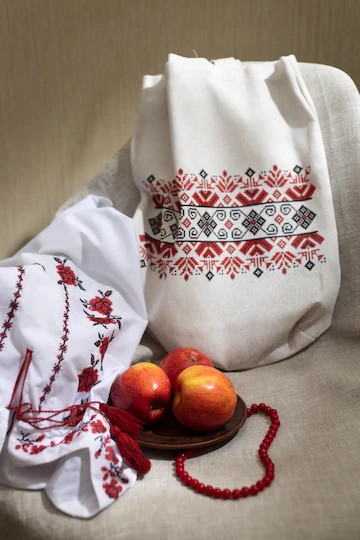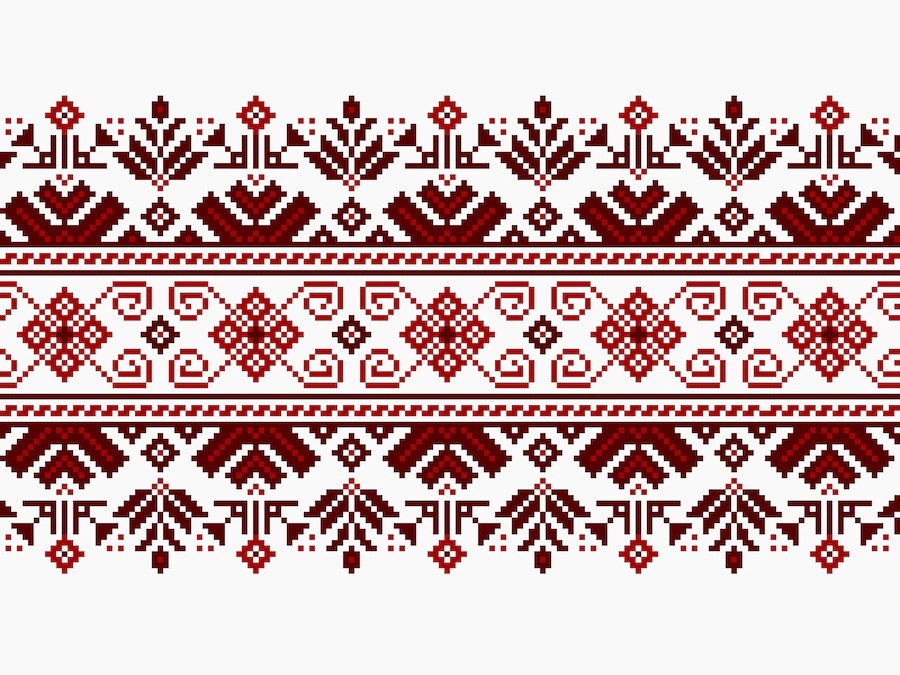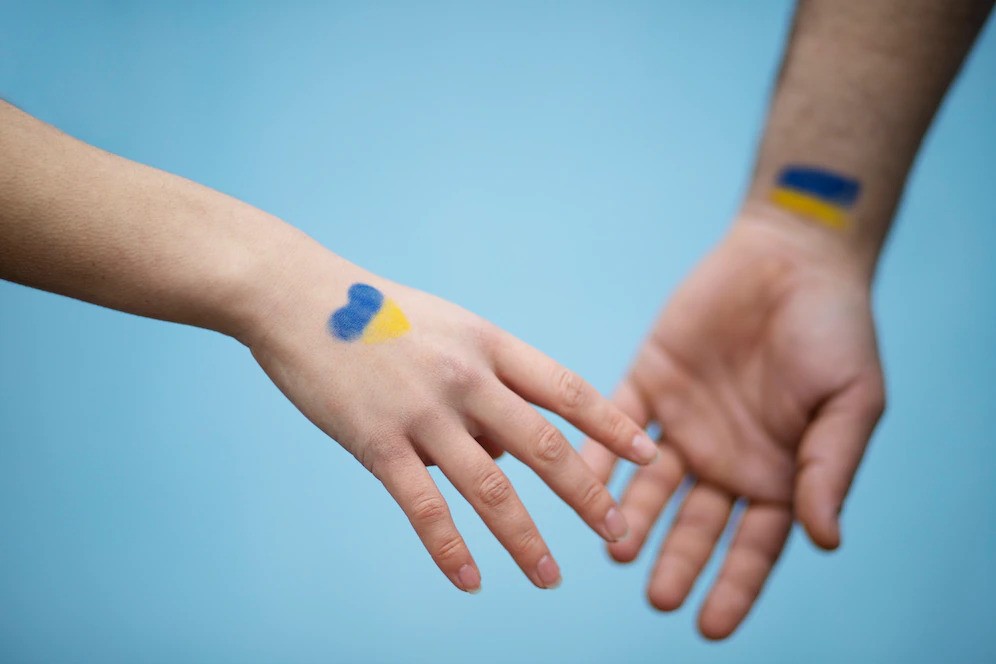Ukrainian embroidery: history, symbolism, and features
22 December 2022
What is the first thing that comes to your mind when you think of Ukrainian culture? Most readers will definitely recall borscht, traditional national clothes, huts with thatched roofs, kobza, and… embroidery. Yes, it is embroidery that is an important part of our culture and traditions, and it is vyshyvanka (embroidered shirts) that are now worn to feel part of the great and strong Ukrainian nation.
However, when exactly did Ukrainian folk embroidery, which we all saw and knew, originate? In order to understand this, we suggest you plunge into the history, symbolism, and features of embroidery art.
History of Ukrainian embroidery
To understand what exactly all those patterns and ornaments mean, let’s go back to ancient times, namely the 1st century BC, the period when the Sarmatians lived and worked on the lands of modern Ukraine, who, like the Scythians and Cimmerians, decorated their clothes and utensils with patterns depicting swastikas, geometric shapes, and wavy ornaments. This is evidenced by the annals of Herodotus, the ancient Greek historian, as well as the excavations of archaeologists. So, in the Sokolova Grave, in the territory of the modern Mykolaiv Oblast, a Sarmatian priestess was found, who was buried with a piece of silk fabric with an embroidered gold ornament. Historians believe that in those days, similar products were made “in the cut” when the pattern itself was first laid out with gold thread and then the ornament was sewn to the fabric.
Archaeologists have also managed to find ceramic pots and dishes created by the Tripilians, which were also decorated with wavy and complex patterns. The next important find, which only confirmed the guesses of scientists regarding the thousand-year history of Ukrainian embroidery, was the Martyniv treasure, a treasure of more than twenty products dated to the 6th – 7th centuries AD, found near the village of Martynivka in the Cherkasy region. During the search, a metal figure of a man wearing a shirt with embroidery on the chest was discovered. Later, similar finds were also made on “stone women” in the steppes.
Another significant evidence of the prevalence of embroidery among the population and nobility of that time was the Ipatiev Chronicle, where the author described the outfit of Danylo Halytskyi on the day of his meeting with the king in 1252, which was lined with gold lace. Modern historians are certain that the Slavs, the direct ancestors of Ukrainians, wore embroidered clothes even after the 10th century and also created schools where the craft was taught to all who wanted to. There is evidence that even Volodymyr Monomakh’s sister Anna organized an institution where girls were taught embroidery with silver and gold threads.
Despite close contact with other people and countries, traditional Ukrainian embroidery has not been affected by foreign influences and has preserved its authenticity and uniqueness. In addition, over the years, the ornaments of embroidery art have become not only a decoration for clothes but also for towels, blankets, and kitchen utensils.
The symbolism of Ukrainian embroidery
Over time, the ornaments of Ukrainian embroidery were only improved and refined. Despite popular opinion, our ancestors applied patterns not only to decorate things but also for protection, defense, and support. The flowers we all recognize appeared only in the 20th century, while in more ancient times, strict, clear, and direct ornaments predominated, each of which had its own symbolism and meaning. The entire painting was created so that even the smallest element carried a sacred meaning and had special importance. Let’s consider a few of them:
- The swastika, or svarga, is a symbol of the Sun in the form of an eight-pointed star, a sign of the guardian angel, Christmas carols, and stars;
- The well is made of two lines crossed diagonally to represent the connection between the worlds, as the well was thought to be a place where the ancestors’ energy and strength were drawn;
- The snake (“vuzh”) is similar to half of the infinity sign, a symbol of reproductive function and healthy offspring;
- Viburnum is the main tree of Ukrainian culture, which our ancestors associated with the birth of the entire universe, a symbol of blood and immortality;
- Stars are of different shapes, colors, and structures, a prototype of the universe with its order and harmony;
- Birds are represented as images of cuckoos, nightingales, peacocks, doves, and others were widespread, each bird was a symbol of love, procreation, or the home hearth;
- Berehynia is an artificially created image in the form of a flower, which symbolizes Mother Nature, the Tree of Life, and the harmony of existence.
Signs and symbols in Ukrainian embroidery do not end with the ornaments listed above: there were even human prototypes in embroidery, but geometric patterns with a combination of dots, lines, zigzags, and meanders are still considered the first and most canonical.
Each embroidered shirt or outfit contained a certain code of Ukrainian embroidery, with the help of which the person wearing the clothes was “coded” for health, the strength of the family, the help of ancestors, and protection from evil spirits. All these sacred codes were transferred to the fabric, as a rule, by women.
Men, women, and children wore different vyshyvankas: yes, men mostly wore vyshyvankas with geometric designs; women wore vyshyvankas with images of plants, herbs, and flowers; children wore vyshyvankas with symbols of birds, plants, and stars.
Types of Ukrainian embroidery: colors and patterns of embroidery
The art of Ukrainian embroidery consists not only of ornaments and patterns but also of a special color scheme and techniques used when applying embroidery. Yes, there were only 5 main colors, and each of them had its own, separate meaning:
- White is the color of the cult of the Father Creator, a symbol of light and purity, an image of spirituality and innocence, used on shirts that were bleached for three years, left in the sun to be treated with earth, fire, water, and air;
- Black is a “divine graphic”, a symbol of the creation of the world and protection from the unclean, secret knowledge, and power of the earth;
- Red is the union of the foremother and the Father Creator, a symbol of the combination of matter and spirit, the life-giving Sun, the joy of the earth, and ardent love;
- Blue is the color of water and cold;
- Yellow is a reflection of will and happiness.
All these five colors were not chosen by chance: they corresponded to the number of races on earth (European, Negroid, Americanoid, Semitic, Mongoloid) and natural elements (water, cosmic ether, fire, air, earth). As for the technical component of the craft, Ukrainian embroidery patterns were executed as follows:
- Threads. Wool and silk were recognized as the best, which, as our ancestors believed, accumulated information and memory about a person and removed all negativity. Silver and gold threads were used. In ancient times, a thread was spun by hand, and it took up to 8 kilometers of such yarn to make one shirt.
- Cloth. Linen, hemp, and silk prevailed, and from the end of the 19th century — percale, colencore, batiste, china, kumach, muslin, fleece, and other machine fabrics.
- Schemes of embroidery of Ukrainian symbols. The most ancient and authentic methods are considered to be the “puncture”, “seam according to the shape”, “seam in a herringbone”, “seam in attachment”, “iedvabnyi seam”, “seam along a rope”, and “shell seam”. Later, ribbon and bouquet construction techniques were added to the craft. Our ancestors also liked such embroidery schemes as “straight smooth” and “chain”.
- Decoration. The first decorations of embroidery were gold and silver embroidery, later — netting and weaving, and, at the end of the 19th century, beads and glass beads. There were also herdany, which were necklaces made of beads with embroidery ornaments.
Modern Ukrainian embroidery
The main symbols in Ukrainian embroidery have not disappeared even in our time. Thus, in the 20th and 21st centuries, manual labor was replaced by machinery and engines, and the thread was no longer spun by hand. At the same time, this became an impetus for the popularization of embroidered shirts, because factory-made clothes became more affordable, while authentic hand-embroidered shirts could only be afforded by the nobility and the rich.
Now the embroidery and the embroidered ornaments themselves do not carry such a sacred meaning that our ancestors attached to them before, because most of these symbols were pagan, and modernity does not divide this ancient religion. In the 21st century, embroidery became a symbol of patriotism, national identity, and pride in one’s origin. Even before the Orange Revolution, this type of clothing was perceived exclusively by the community as a stage outfit, while now embroidered dresses are worn for holidays and even mixed with everyday clothes. Over time, embroidery on such materials as organza and Euromesh was added, which made the range of embroidery even wider and more diverse.
Vyshyvanka Day in Ukraine, which is celebrated every year on the third Thursday of the last month of spring, should be highlighted as a separate point. The holiday is celebrated with the massive wearing of embroidered dresses, fairs, flash mobs, dances, and concerts throughout the country. The event was celebrated for the first time in 2006 when a student of the Chernivtsi National University suggested that her classmates wear embroidered dresses, and her idea was supported not only by her classmates but also by other students and even teachers.
Now, more and more Ukrainians are starting to wear vyshyvanka not only to preserve our culture but also to show their love for the Motherland and internal patriotism!
5 reasons to wear embroidered clothes
1. Manifestation of patriotism
Ukrainian culture and identity have experienced many ups and downs, and that is why it is now so important not to forget our peculiarities and traditions, which stretch back thousands of years. By wearing an embroidered shirt, you become an example of the fact that you should not shy away from your origin, and that being Ukrainian is a source of pride, strength, and honor.
2. Protection and defense
Our ancestors believed that every ornament and pattern embroidered on clothes could protect its owner from adversity and misfortune, as well as help in difficult times. Products made by hand by those who love and respect you (mother, grandmother, etc.) are considered especially significant.
3. Trend and style
Thanks to our modern society, embroidered jackets have become a fashion trend that can be successfully combined with jackets, jeans, and even sneakers. It is worth paying attention to collections from such designers as Dolce Gabbana, Nina Ricci, and Valentino, who actively add embroidered ornaments to their creations.
4. Convenience and comfort
Vyshyvankas have long been considered comfortable and spacious clothes that do not restrict movement. Moreover, such shirts are made of natural fabrics that allow air to pass through well.
5. Topicality
Embroidered jackets, unlike jeans, jackets, or other types of clothing, do not go out of fashion and do not lose their applicability over time. By buying an embroidered shirt, you will get clothes that will always improve your look.
Conclusion
Ukrainian embroidery takes its roots in the 1st century BC and stands out among other types of crafts for its uniqueness, authenticity, and originality. From time immemorial, embroidery had a sacred meaning, and the applied ornaments symbolized protection from misfortune, love, family, fertility of the earth, and unity with nature. Today, the embroidered shirt has become a symbol of patriotism and national identity, and it is worn not only on holidays but also in everyday life!






